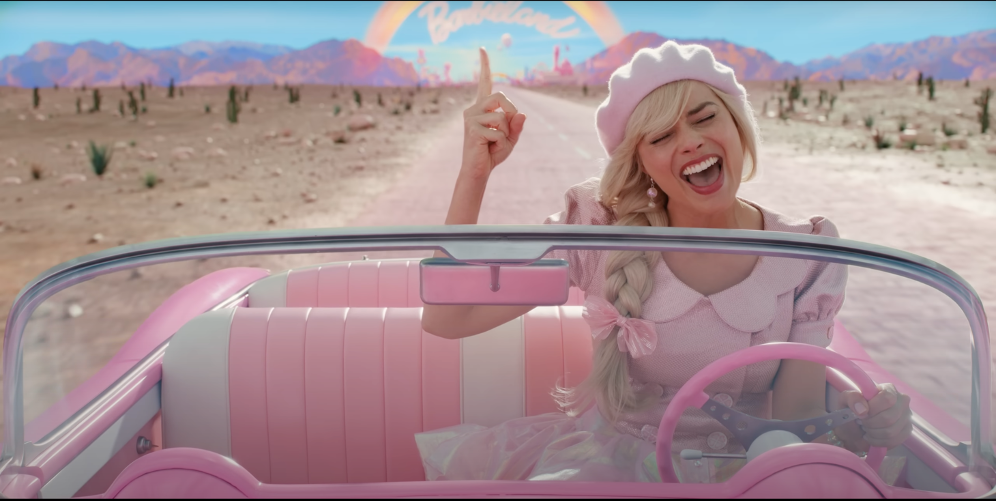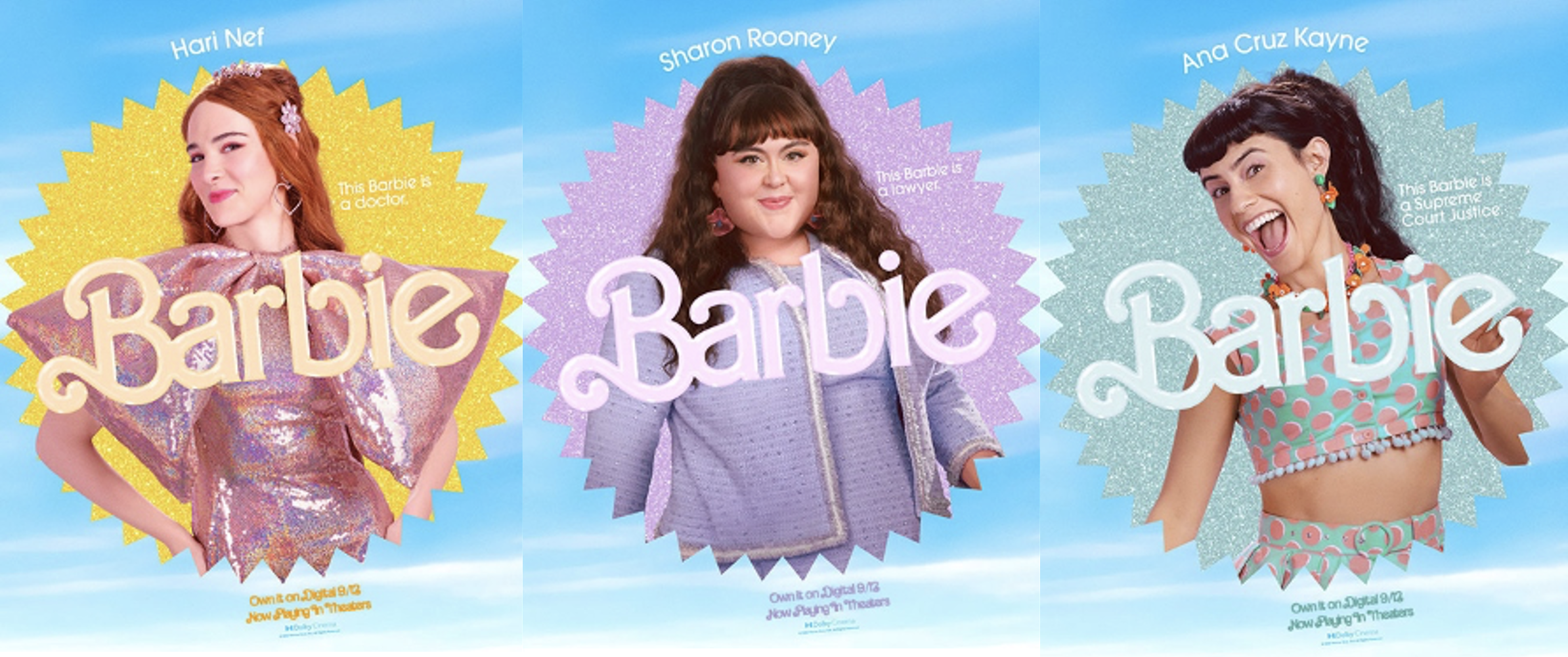I’m a Barbie Girl: Becoming the Barbie Spectator On and Offline
Margaret Rossman / Bellarmine University

As Greta Gerwig’s Barbie (2023) continues to work its way up the charts—currently sitting just outside the all-time top 10 domestically[1]—it has found itself in the middle of many intertwining narratives. With the future of theatrical release unclear, an examination of its success and its audience has intersected with considerations and critiques of its popularity. Barbie was always going to be scrutinized for its takes on gender, and this has been emphasized both by its female director and its juxtaposition to Christopher Nolan’s Oppenheimer (2023), whose same day release led to the highly popular “Barbenheimer” meme. Though the meme itself encouraged crossover audiences and increased success for both films, opening weekend was still highly skewed, Barbie with a 66.2% female audience, and Oppenheimer with a 70.7% male audience. Yet somewhat lost in the discussion of this competition is how Barbie’s success can be linked to a theatrical event characterized by a feminine viewing experience and in turn, how this social space—and its expansion online—can fill in some of the limitations of the text itself.
Even as the film debuted to strong reviews, many critics inquired about the authenticity of corporate pushback within a movie produced by Mattel, the manufacturer of the central product. As Alison Willmore of Vulture noted, “But the trouble with trying to sneak subversive ideas into a project so inherently compromised is that, rather than get away with something, you might just create a new way for a brand to sell itself.” Of course, the Barbie movie was indeed part of an ongoing larger rebrand strategy that attempted to refocus the concerns about Barbie’s effect on body image to a “girlboss” message of empowerment. The 2015 “Imagine the Possibilities” ad for Barbie, where Barbie can be “anything,” is not too far off from the ad campaign for the film, announcing that “This Barbie is a doctor,” or “This Barbie is a lawyer,” or “This Barbie is a Supreme Court Justice.” A fine message to be sure, but always right on the border of suggesting that a feminist politic can be had largely through self-empowerment. It should be noted that even though Barbie addresses the systemic issues of patriarchy that keep the concept of “Barbie” from changing the power dynamics of the “real world” in the film, the movie’s switch to a more personal narrative journey for Stereotypical Barbie leaves us without real solutions for combatting such a structure.

Similar to debates around “girl power” in the 1990s, Barbie’s association with “girliness” and consumer capitalism also requires a consideration of postfeminism. As Karen Orr Vered and Christèle Maizonniaux examine in discussion of the Barbie straight-to-dvd movie, “Mattel has effectively developed a format in which the key messages of post-feminism are foregrounded for girls.”[2] Yet even Vered and Maizonniaux acknowledge that there is potential in the agency of the characters, alongside the limitations of these Barbie stories. It is this tension that becomes a central part of the messiness of the Barbie movie discourse as well. The limited Hollywood space given for narratives for women suggests we may have to find our inspiration in these imperfect tales—a key component of the “both/and” of “hegemony and contradiction,” as Judith Mayne discusses.[3] The desires that brought out so many women of all ages to the Barbie movie suggests a yearning to embrace a girliness and reclaim the toy they once played with, which can’t simply be dismissed as falling victim to the dominant narrative.
While the text itself involves many opportunities to grapple with these tensions, it is in the audience response that we can most easily see the promise that the film provides. Probably the most divisive quote from the film comes as the creator of Barbie, Ruth Handler (Rhea Perlman) announces to Stereotypical Barbie (Margot Robbie), “We mothers stand still so our daughters can look back to see how far they have come.” As many have noted, the self-sacrifice in this maternal depiction is a contradiction and a dismissal of the different roles women inhabit—and pushes back on the other messages of the film. Yet an equally strong response to this quote online comes from women who mention crying at the sentiment, largely in relation to their own feelings of admiration for what their mothers had given them—mothers who in many cases were in the audience with their adult daughters as part of the viewing experience. This homosocial bonding amongst mothers, daughters, sisters, and best friends becomes as much a part of the Barbie experience as the viewing of the film, and it provides resonance to give greater significance to the messages of Barbie. In the theater where I viewed the film, spontaneous applause occurred after Gloria’s (America Ferrara) monologue about how “it is literally impossible to be a woman.” In some ways, this sentiment can feel rehashed from the many times it has manifested across media already. But in the context of the collective viewing experience, it clearly had the potential to make the audience feel seen and heard, which is why they responded out loud to the film and each other.
I have written elsewhere about the functions of the feminine film event and the performance of emotion, particularly in the midnight screening of The Fault In Our Stars (2014).[4] The crossing of off and online spaces became significant to this audience as they displayed photos across Twitter of used tissues and mascara-bled eyes to showcase all their “feels.” For Barbie, we see a similar desire to capture and spread the experience, but the expectations of TikTok transform these behaviors into something different. Communal outfits and attire are now produced into edited videos and set to music from the film. More importantly, it is no longer enough for fans to record their own reactions, but they now film live the snippets of the movie that have caused these reactions. While we could certainly discuss the overall changes in film-viewing etiquette that has caused this, this also brings the film in line with the live concert feed amongst fans on TikTok (particularly popular for the similarly girly Taylor Swift’s Eras tour) pushing the live experience out into the digital world.
@barbiethemovie From all of Barbie Land, THANK YOU to all of the beautiful Barbies and Kens who helped get this pink party started! 🤩🎀💞 #BarbieTheMovie ♬ original sound – Barbie Movie
Another common TikTok response comes in the form of commentary on other viewers—noting the moms and daughters, groups of friends, cute grandparents, and their emotional reactions. Privacy concerns aside, the “being seen” of the event extends to the viewing of others as well as the showing of themselves. TikTok also allows for the filling in of narratives only hinted at in the film. The potential of empowered play created through the concept of “weird Barbie” never gets fully examined on screen, but through the digital space we can see many examples of various “weird Barbies” of the audience’s past.
@billieeilish ♬ original sound – Billie Eilish Home
The biggest Barbie trend on TikTok comes from examining “girlhood” itself with a template promoted by Billie Eilish, using dialogue from the film (“Take my hands, close your eyes, now feel”) and the intro notes to Eilish’s song from the soundtrack, “What was I made for?” Overlaid on home movies from her childhood is the word, ‘girlhood.” While many of the videos in this trend reference the movie and moviegoing experience—tying it to the concepts of girlhood—it also allows exploration of all this idea means, and gives voice to a key part of feminine identity that is often dismissed. In this way, the film can ultimately serve as the prompt that goes beyond the marketed feminism into more complicated ideas.
Image Credits:
- Still from Barbie (2023) trailer (Author’s screengrab)
- “Imagine the Possibilities” Barbie ad (Official Barbie YouTube Account)
- Barbie poster images (Official Movie Website)
- TikTok from @Barbiethemovie thanking fans for their part in making Barbie a phenomenon
- TikTok from @billieilish promoting “girlhood”
- As of Sept. 17, 2023, Barbie has earned $626 million domestically, surpassing The Avengers (2012) for the 11th spot on the all-time highest grossing domestic films. See Rebecca Rubin, “‘Barbie’ Outpaces ‘The Avengers’ as 11th-Highest Grossing Domestic Release in History,” Variety, September 17, 2023. [↩]
- Karen Orr Vered and Christèle Maizonniaux, “Barbie and the Straight-to-DVD Movie: Pink Postfeminist Pedagogy,” Feminist Media Studies, 17, No. 2 (2015): 210, https://www.tandfonline.com/doi/full/10.1080/14680777.2016.1178158. [↩]
- Judith Mayne, The Women at the Keyhole: Feminism and Women’s Cinema (Bloomington, IN: Indiana University Press, 1990), 25. [↩]
- Margaret Rossman, “Exhibiting Emotion: The Female Fan Performance of Affective Agency in the Tween ‘Midnight’ Premiere Screening.” In Mediated Girlhoods: New Explorations of Girls Media Culture: Volume 2, ed. Morgan Blue and Mary Celeste Kearney, (New York: Peter Lang, 2018), 103-118. [↩]